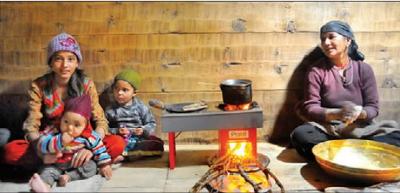
Chennai:
At the crack of dawn, 14-year-old Dsudee begins an arduous journey to collect firewood. Shivering under her monkey cap and sweater, the Class 9 resident of Khalsa village in Uttarakhand struggles through rocky terrain and uneven paths. She repeats this trip thrice a day, walking nearly 18km in total. Once home, she helps her grandmother make a tall stack of rotis for the family, coughing and battling tears due to the clouds of smoke from the chulha or mud stove. But her difficult lifestyle is slowly changing for the better after ‘clean stoves’ were distributed to houses in her village as part of the Himalayan Clean Cooking Project (HCCP).
Launched by the Chennai Hub of the Global Shapers Community and the Himalayan Environment Trust in 2014, the project seeks to supply clean cooking stoves to remote mountain communities. These stoves combust the same fuels – wood and biomass – more efficiently. “We got the idea when we were stuck in a hailstorm during a trek in Himachal Pradesh. We took shelter in a hut but the smoke was suffocating,” says Varun Gunaseelan, project director.
In an article on the World Health Organisation (WHO) site dated March 2014, an estimated 700 million people in India still rely on solid fuels and traditional cook stoves for domestic cooking. It further states that having an open fire in the kitchen equivalent to burning 400 cigarettes an hour. Women and young children are considered the first victims of smoke-related acute and chronic respiratory and cardiovascular diseases. “According to WHO estimates, in 2012 there were close to 1.7 million premature deaths attributed to household air pollution from cooking in the Southeast Asia region with India shouldering the biggest burden,” it says.
After extensive research and surveys, the HCCP team distributed their first batch of single-burner stoves to all the 55 households in Sidri village in Uttarakhand, last year. “We conducted road shows and live demonstrations by boiling water. On seeing that the water heated much faster, many locals placed orders,” says Varun, adding that the stoves were provided at a discounted price of 1,000.
The village headman, Ram Singh Pawar, said that households continued to use the appliance as it produced ‘less smoke, cooked food faster and used lesser wood.’
For the next phase of the project, the team partnered with Puducherry-based social enterprise, Prakti, to provide double-burner stoves suited for Himalayan families. The stoves accommodate wood, cow dung and agricultural wastes without processing while the steel combustion chambers ensure the fuels combust more completely.
“The stoves produce 80% to 95% less smoke compared to traditional mud stoves and three-stone fires. It also uses 40% to 80% less fuel and reduces deforestation,” says Prakti program officer Mimi Liu, adding that cooking time is brought down by about 70%.
Limited access to healthcare facilities in these remote areas makes fuel-efficient stoves the need of the hour.
“Using these stoves is crucial as early exposure to large amounts of smoke and pollutants could lead to asthma, wheezing or bronchitis in children below five years and prolonged exposure can cause lung cancer,” says Dr Samantha Balaji, who is pursuing her masters in paediatrics.
The team now conducts periodic roadshows and awareness programmes through student volunteers for various mountain communities on clean cooking methods.
source: http://www.timesofindia.indiatimes.com / The Times of India / News Home> City> Chennai / Aditia Maithereya / TNN / July 24th, 2016